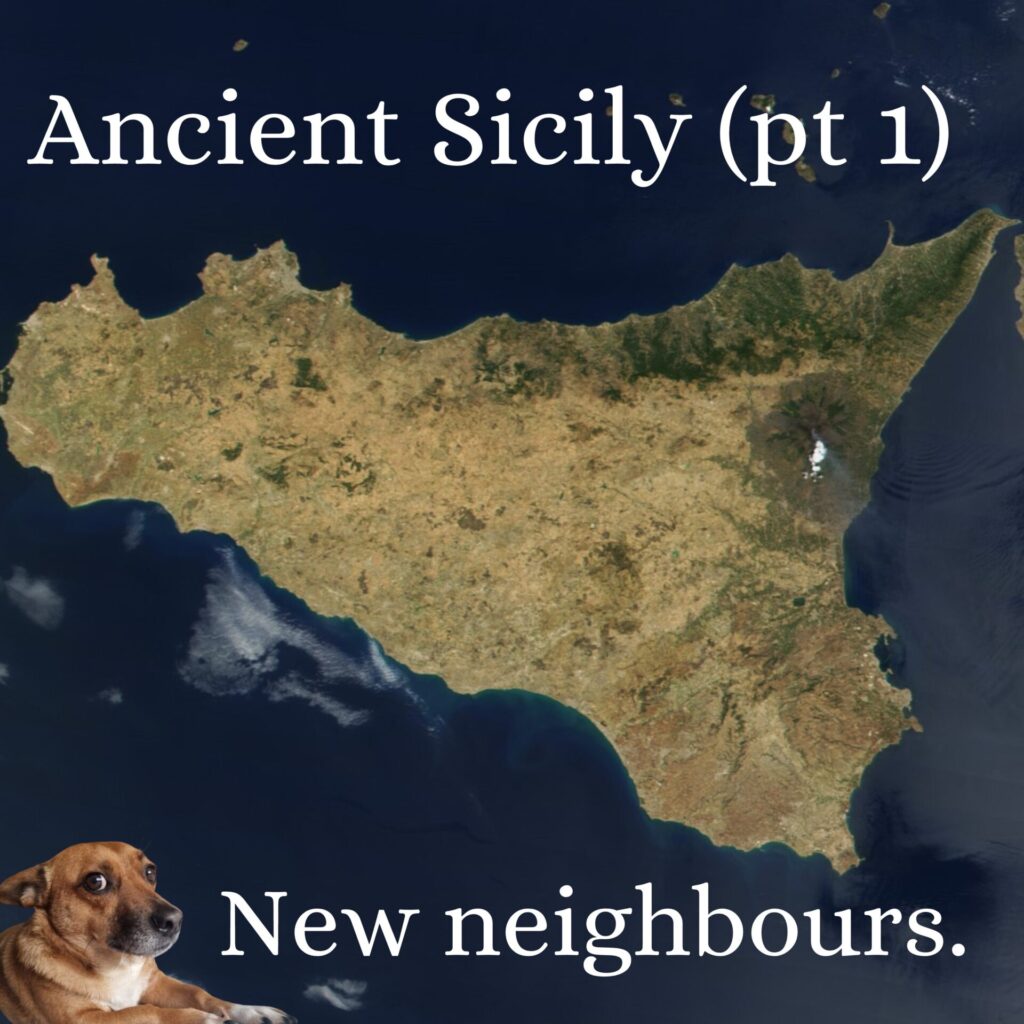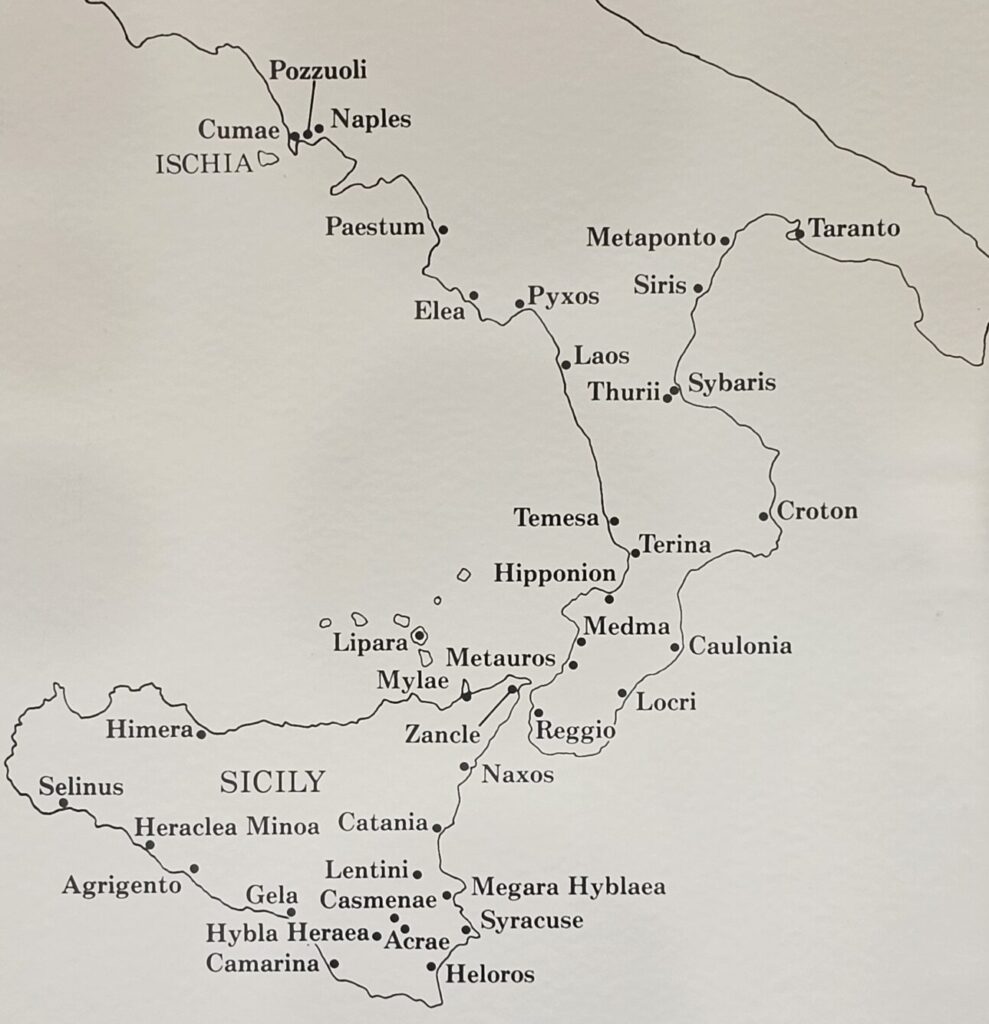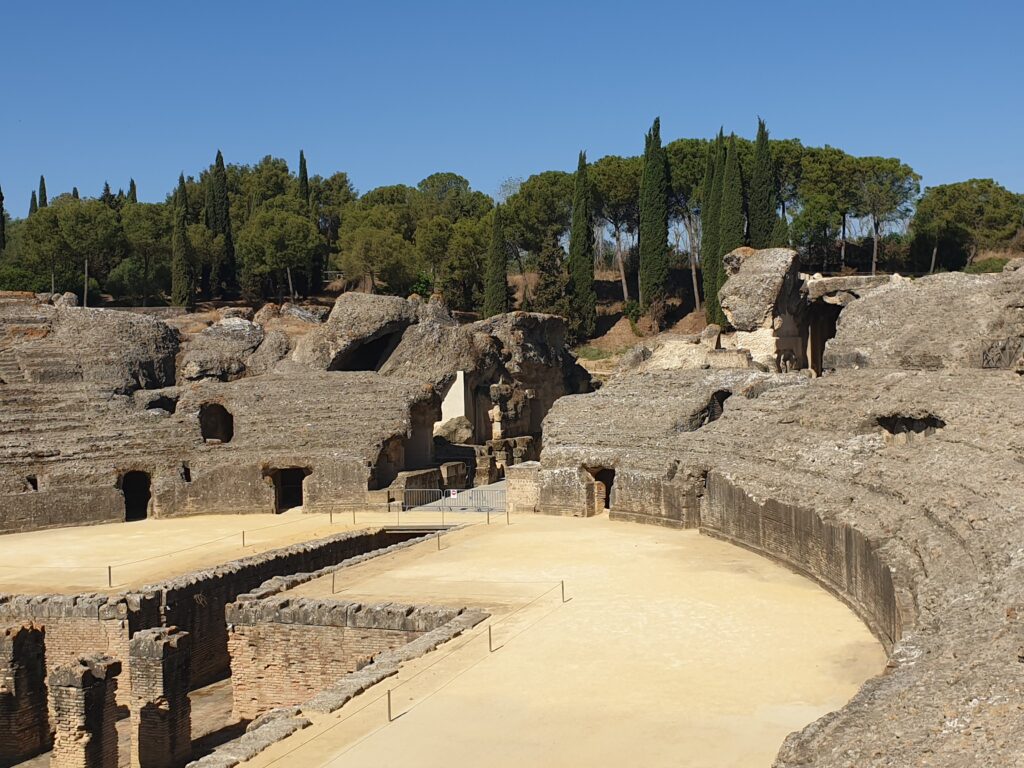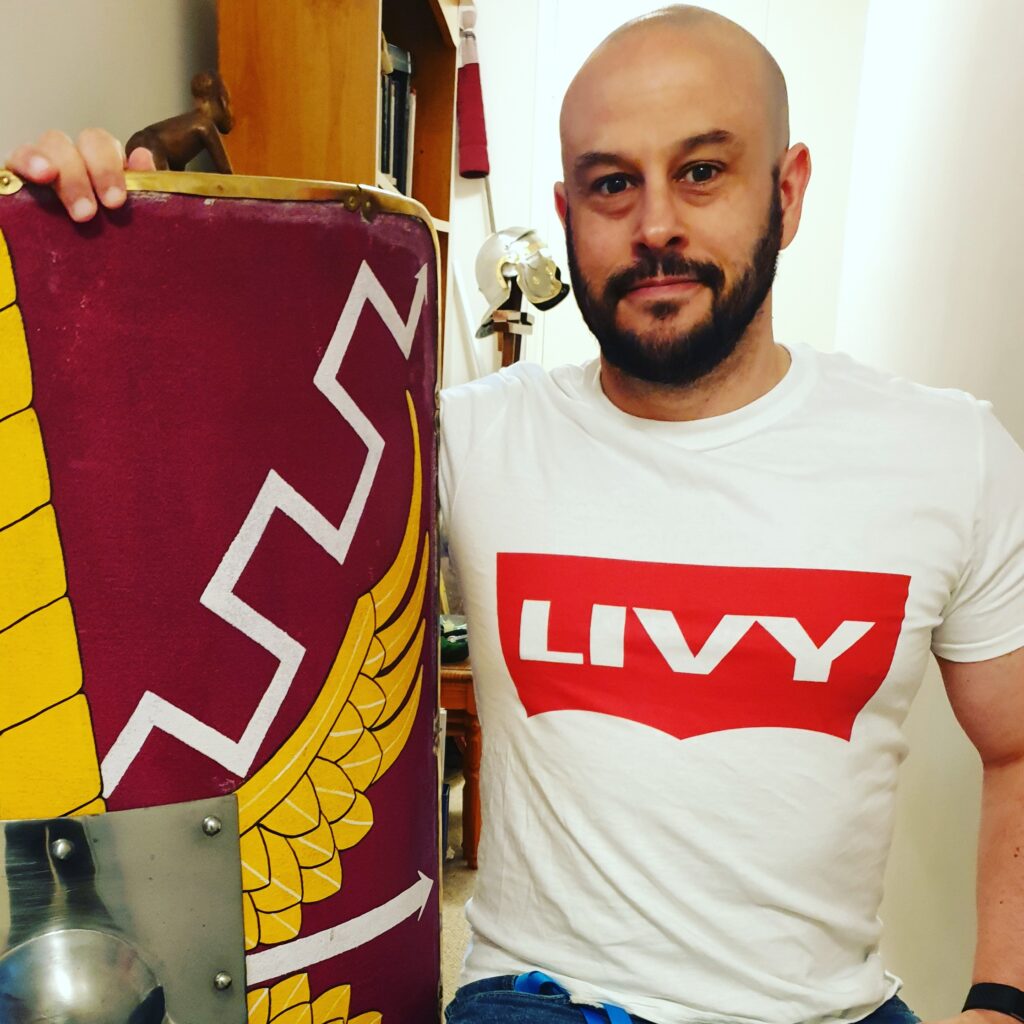Hope you enjoy the episode I’m still unsure what I have let myself in for as there is a lot of content. Anyway, here is some supporting content which I hope helps. I recently received some lovely feedback saying that the reading list gave that person more sources to use and ideas to research.
H.M. Classics Academy.
If you weren’t aware I don’t charge for adverts, most are swaps or simply ideas which I hope you gind useful. Helen was a guest on an episode where she selected 6 fantasy dinner guests, why not check it out? In any case she runs the H.M. Classics Academy – if you’re looking to learn have a look at her site and have a chat. Helen is @ClassicsAcademy on X and apparently also on Facebook.
Maps of Sicily.
I hope that my brief description of a walk round Sicily resembled the island. As ever, it’s easier to visualise. Let’s start from space.
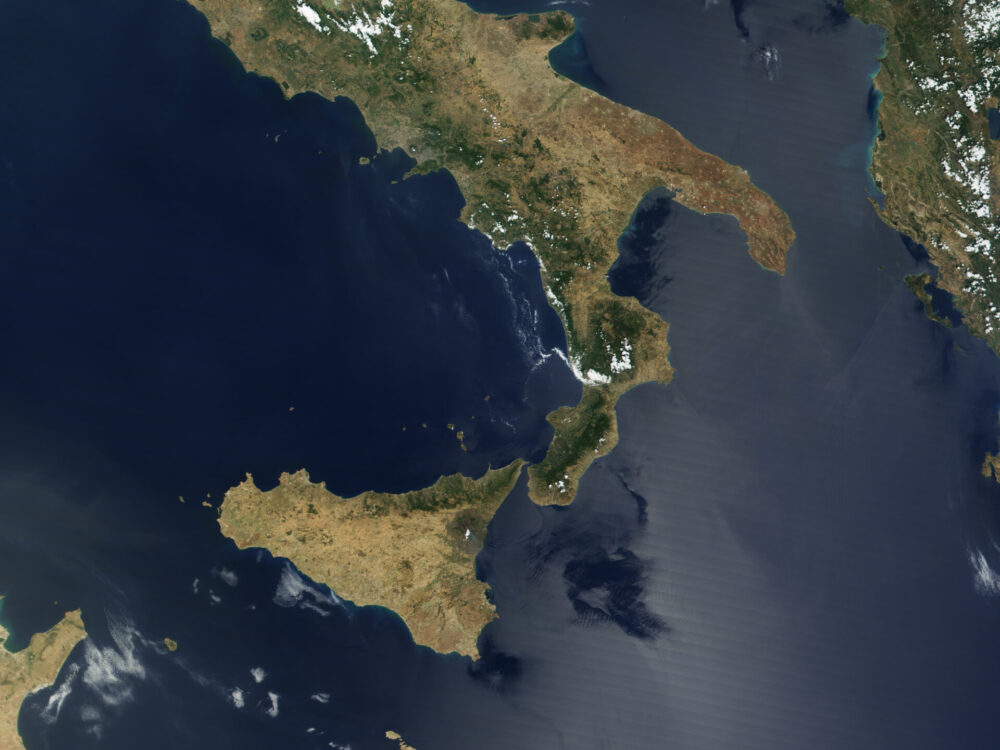
Here it is with the modern place names.
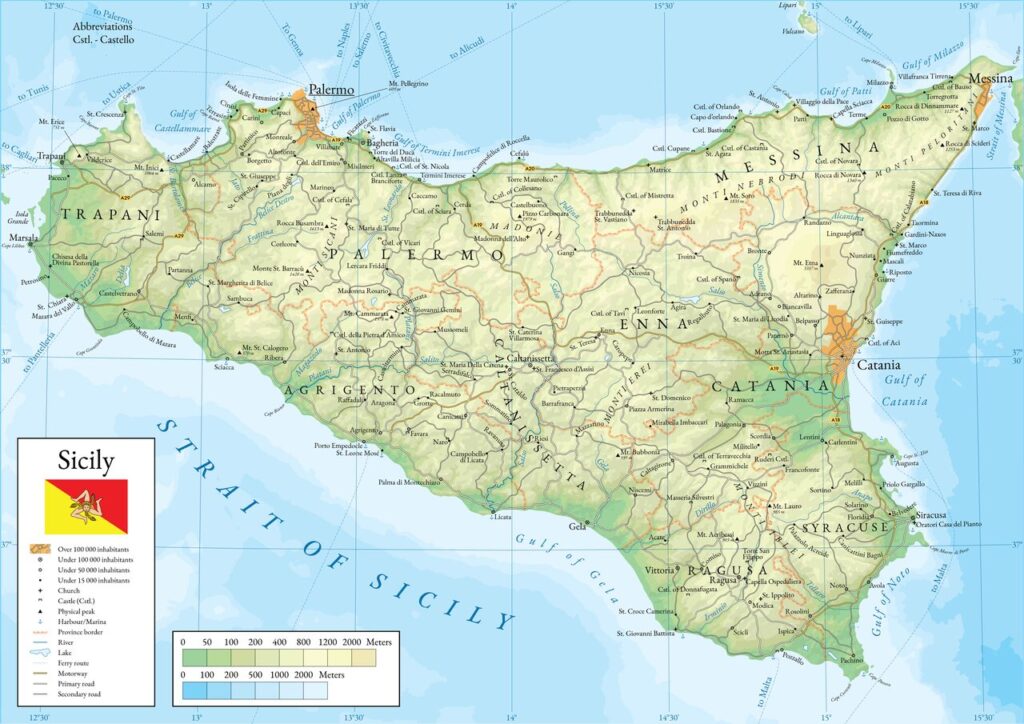
This gives a bit more of a wider view showing the Greek colonies on southern Italy and Sicily, some date to after the period covered by this episode but hopefully it should give an idea.
Motya.
As you heard Motya is on the modern day island of San Pantaleo in the Stagnone lagoon. This is on the western tip of Sicily.

This is the view from the south, you can make out the kothon area (the pool) in the bottom left of the island. If you wanted a sneak look at how the pool may have been used, here’s a piece I did on it.

Other locations mentioned.
Firstly, a shout out for Chalkis on the island of Euboea (in the centre of the map).
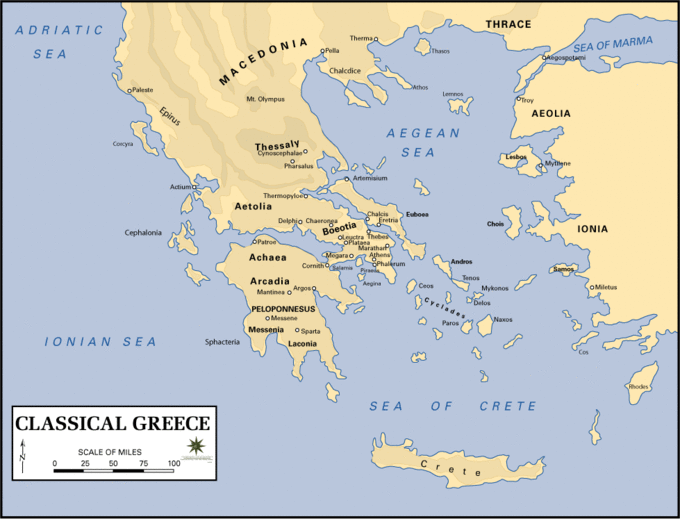
A great map showing the Mediterranean and those Phoenician trade routes. Here’s the article it’s from.

I took a photo of this gold bowl at the British Museum a few years back, it’s thought to have come from Gela and been made circa 600 BC.
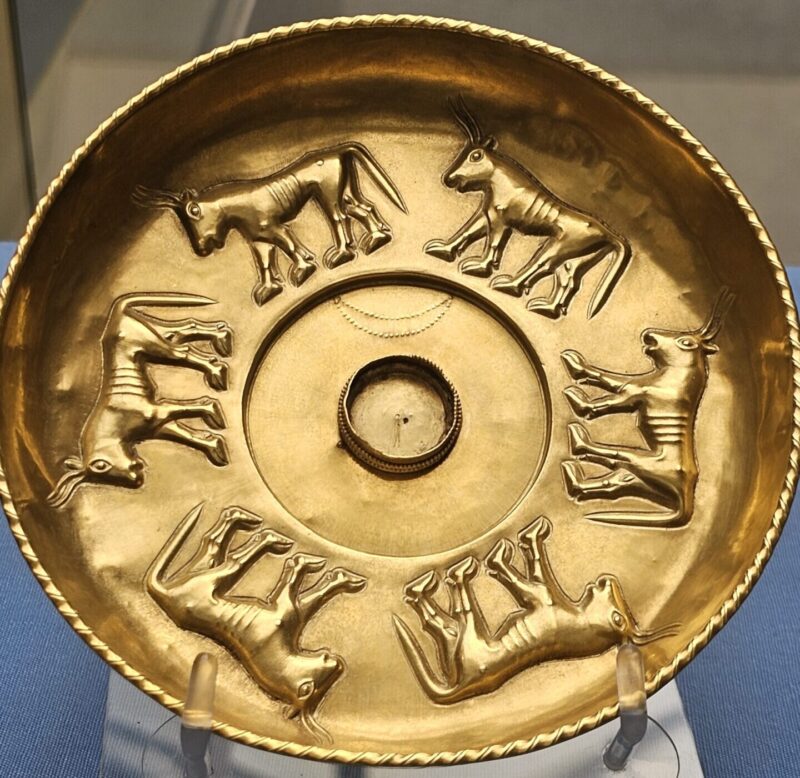
The cup below is much older, dating to 2200-2000 BC and made by the Castelluccio culture.

Reading List / Sources used.
Balco, W. Thinking beyond imitation: Mixed-style pottery in ancient western Sicily.
Booms,D. Higgs, P. Sicily culture and conquest.
Bonasera et al. Geomorphological and Structural Assessment of the Coastal Area of Capo Faro Promontory, NE Salina (Aeolian Islands, Italy)
Chiocci, FL & Romagnoli, C. Submerged depositional terraces in the Aeolian Islands.
De Marchis, M. Ciraolo, G. Nasello, C. Napoli, M. Wind- and tide-induced currents in the Stagnone lagoon (Sicily).
Dominguez, A. Greeks in Sicily in ‘Greek Colonisation and account of Greek colonies and other settlements overseas’.
Falsone, G & Sconzo, P. New investigations in the north-east quarter of Motya. The archaic cemetery and building.
Gonzalez de Canales, Serrano & Llompart. The Pre-colonial Phoenician Emporium of Huelva ca 900-770 BC
Lentini, Blackman & Pakkanen. The port in the urban system of Sicilian Naxos in ‘Ancient Ports, the geography of connections’
Lentini, M. Recent investigation of the early settlement levels at Sicilian Naxos.
Lauria G, Sconzo P, Falsone, Sineo L. Human remains and funerary rites in the Phoenician necropolis of Motya.
Malone, C. The Italian Neolithic: A Synthesis of Research
Nigro, L. The sacred pool of Ba’al: a reinterpretation of the ‘Kothon’ at Motya.
Nigro, L. From Tyre to Motya: the temples and the rise of a Phoenician colony.
Nigro, L & Spagnoli, F. Landing on Motya.
Nigro, L. Before the Greeks: the earliest Phoenician settlements in Motya – recent discoveries by Rome.
Nigro, L. The Temple of Astarte “Aglaia” at Motya and Its Cultural Significance in the Mediterranean Realm
Oliveri, F & Toti, M. Animals from Motya: Depictions and Archaeological evidence in the Phoenician town in Sicily.
Orsingher, A. The ceramic repertoire of Motya:origins and development between the 8th and 6th centuries BC.
Somma et al. The discovery of a Mycenean-type tholos tomb in the Bronze Age Necropolis on the Gazzi buried floodplain (Messina, southern Italy): new geological and anthropological data.
Spagnoli, F. Phoenician Cities and Water: The Role of the Sacred Sources in the Urban Development
of Motya, Western Sicily.
Spagnoli, F. Altars and cult installations of Punic tradition in Western Sicily.
Suarez-Padilla, J. Jiminez-Jaimez, V. Caro, J. The Phoenician diaspora in the westernmost
Mediterranean: recent discoveries.
Tanasi, D. Sicily Before the Greeks. The Interaction with Aegean and the Levant in the Pre-colonial Era
Transcription.
Time for Sicily, so get your bags packed but don’t expect much space on the beach. It’s the first episode of a series about ancient Sicily on the Ancient History Hound podcast.
Hi, my name’s Neil and, as you just heard, this episode is the first in a series on ancient Sicily – something I’ve wanted to do for a long time. Over the course of several episodes I will cover the period from when the island became a home for Phoenician and Greek colonies through to when it became a Roman province.
In this first episode I’ll be starting with the early history of Sicily and then with the arrival of the two main cultures who settled there, the Phoenicians and the Greeks. I’m going to unwrap what those early settlements were, what they did and how they interacted with the indigenous people on the island. This will take me up till around the middle to late 7th century BC (that’s 650 to 600 BC) or thereabouts. As you’ll hear there’s a lot to cover.
Before I begin there is the standard appeal where I ask for reviews if you can spare the time. Platforms such as Spotify and Apple use the stars a podcast gets to help promote across to new listeners. With Spotify you can even leave a review for a specific episode. My marketing budget is as small as those tiny violins you can hear playing, in fact I have no marketing budget. This part is over to you. So if you can rate or review just know it’s really appreciated.
You can find more ancient history content on my instagram, youtube, tiktok and X where I am ancientblogger. On X this podcast also has its own account @houndancient. All of these links, plus more, is on my ancient history website or blog, ancientblogger.com and I’ll be putting episode notes on there with a reading list, images, transcription and anything else which I hope helps.
For the old school amongst you there is my email, you guessed it, ancientblogger@hotmail.com – in short there are many ways you can get in touch if you so wish. Please do as I like to engage with anyone who listens to me . Finally, thanks to all the returning listeners. I appreciate your support. Oh and one thing specific to this episode, I’m doing a lot of different pronounciations so apologies if I don’t get these exactly right.
To start with let’s orientate ourselves with some geography and a bit of a walk. Sicily is the largest island in the Mediterranean, it covers just under 26 thousand kilometres squared and if it were a state in the USA it would be slightly larger than Vermont and New Hampshire and just a bit smaller than Massachusetts.
The island famously takes the form of a triangle, sort of. But let’s imagine travelling along the coastline of Sicily. We’d start at its western tip and on the north coast which runs on an east/west axis. After walking roughly 380km east you’ll reach the eastern end and from here you’d make out the toe of Italy.
Now we’d need to turn south with the Sicilian interior on our right. On our left is an initially narrow body of water sat between us as and the that famous toe end of Italy. This channel separating us is known as the strait of Messina and – a mere 3km at its narrowest point. According to myth it was here where Scylla and Charybdis both hung out. Scylla was a terrifying creature who would lean from the cliffs and snatch sailors from their ships. Charybdis was a whirlpool which would swallow down whole ships. Not an easy place to navigate.
Our journey now takes us south along Sicily’s eastern coast, some 254 km. It’s the shortest coast but as you’ll hear in this episode it became the busiest. To our left the narrow strait of Messina open out into the Mediterranean and to our right we’d see a feature which dominated the island and still does. Mount Etna.
Where Etna looms large in the geographical context it also became an important location in myth. Aeschylus, the Greek playwright, wrote how the forge of Hephaestus sat atop the volcano whilst the monster Typhon was trapped underneath it. This then helped explain the raging fires on the volcano and occasional rumble from below.
Once we’d made it to the bottom end of the eastern coast we’d turn right once more and head northwest along the southern coast, a distance of some 380 km. Just as a caveat these distances are rough calculations, you might see figures a bit shorter but they are sometimes listed as the crow flies. However, these are winding coasts, not straight lines, hence the increased distance. But I am sure worth it and perhaps walking round Sicily’s coast should go on my bucket list? Though I am focused on the coastline there’s much to be said about the interior of Sicily, it’s a place of hilly climbs beauty and tragic myth. A central region there, known as Enno, was where Hades abducted Persephone. Indeed Persephone was strongly linked to the island and whilst on the subject of monstrous acts the island was also identified as where Odysseus met the cyclops.
Moving away from myth and back along the southern coastline we’d eventually find ourselves back on that western tip and it’s time to consider the earliest inhabitants of the island. In the 5th century BC the Greek historian Thucydides provided a commentary about who they were and how they got there. Thucydides split the indigenous peoples into three tribes or factions, the Elymians, Sikels and Sicani.
The western corner of the island was home to the Elymians, who, as Thucydides reckoned, were settlers who had escaped the destruction of Troy. Occupying the eastern third of the island were the Sikels who had crossed over from Italy and who gave the island its name. In the central third and sandwiched between the two were the Sicani who had emigrated there from Iberia. Thucydides’ account is formed as you might expect from his understanding in the 5th century BC. The reality, as you might have guessed, is that it hasn’t been easy to separate the peoples of Sicily into three distinct groups as Thucydides did. For the sake of ease from now on I’ll be referring to the indigenous people as just that rather than using the labels Thucydides did.
Archaeological evidence indicates there were people on Sicily for a long time. Human activity can be dated as far back as 13,000 BC from stone tools. There is also cave art though the date range is debated and may be later, perhaps as recent as 8,000 BC. In later times Sicily was renowned for its agricultural plenty, it was a grain basket, but from 6,000 BC something very different was farmed there. Not grain or even anything you might wish to nibble upon though it was something which would help you gain food. I’m talking about obsidian.
Just off the north east coast of Sicily are the Aeolian Islands and one in particular, Lipari, had large amounts of this material. These islands were formed as a result of volcanic activity and obsidian is essentially volcanic glass which can be fashioned into possessing razor sharp edges or points. Even today obsidian is prized for its cutting prowess. This was the equivalent of a laser, it could cut finer, deeper or more easily than more or less anything else around. Obsidian knives or arrowheads were highly sought after.
Obsidian was soon traded within the immediate region, it made its way to southern Italy, Sardinia and even as far as Croatia. However, in the middle of the 3rd millennium BC, that is around 2,500 BC the market for obsidian seems to have collapsed, perhaps due to the preference for copper and metalworking. It was around this time that the Castellucio culture arose and dominated the south-eastern part of the island till around 1500 BC. These people were largely farmers who herded cattle and grew crops in the Sicilian interior but also traded with nearby Malta, Sardinia, and southern Italy. Around 1500-1200 BC we have the Thapsos culture, these were people who were located on the south-eastern corner of the island and their tombs featured imported Mycenaean and Cypriot pottery, which indicated that Sicily had links to the eastern Mediterranean.
The period following 1200 BC saw a breakdown of these maritime trade routes and on Sicily the rise of the Pantalican culture, again based in the south-eastern part of the island. Where coastal settlements had been a viable option the deterioration of trade routes mean that people turned more to the inland of Sicily. This ran through till around 650 BC and so it was this period which witnessed newcomers to the island. I should add that what I have given is a very basic overview of several thousand years but I think it’s important to acknowledge that when those first settlers arrived they did so no to a wild backwater but somewhere which had been part of the wider Mediterranean cultural exchange for a long time and also somewhere with layers of its own history.
Up until now I’ve spoken about Sicily pretty much in the context of the eastern part of it due to the finds there. But the first of our settlers weren’t interested in this end of the island. Instead, they found a spot on the western tip, these were the Phoenicians, and they were to become a force to be reckoned with.
I’ve mentioned the Phoenicians in previous episodes, for example the link with Thebes in mainland Greece and their contribution to what became the Greek alaphabet. These were a people based in the Levant, think modern day Lebanon or thereabouts. Though we refer to them as a singular entity they were much like the Etruscans and ancient Greeks, independent city states with a shared culture. The Phoenicians excelled at maritime trade and had been developing trade routes and networks across the Mediterranean. Rather than one long route their networks seem to have been formed of shorter or medium distance routes knitted together. As such a particular item may be sold in a nearby location or passed from trading point to trading point and ending up a great distance from where it had started.
A good example of the extent of their networks is the southern Iberian peninsula, modern day southern Spain and Portugal. There’s evidence of Phoenician activity there as early as the 9th century BC with the settlement which Heulva now sits on furnished with a Phoenician quarter. In the 8th century BC the Phoenicians went all in and established their own trading posts on the coast. I say trading post but another word used is sometimes colony and here I need to offer comment about that word. To understand what a colony was at this time is to strip it of much of its modern associations and connotations. I covered this a bit more in my episode on Magna Graecia which involved many Greek colonies popping up in southern Italy. Colonies at this time weren’t military ventures sent out by a singular power, say an empire. They were often formed of groups of people, sometimes from different City states in the case of the ancient Greeks, looking to establish a settlement with the idea of accessing choice trade networks or resources. They were not done at the point of the spear, what made a prized spot a prized spot was that it had good networks already there and good interactions with the locals.
Of course, there might be tension and there’s a possible example of that which I’ll come to in this episode. But as a general observation settlers seemed to get on with their indigenous neighbours. They traded, they shared culture and intermixed. This didn’t mean everyone stood around holding hands. These are humans after all, but it’s important to realise that a colony wasn’t an invasive thing. The idea was that you’d benefit more by getting along. If you listened to the episode on Magna Graecia you’d have heard that much of the squabbling, bikering and fighting done by the Greek colonies was with other Greek colonies.
Around 800 BC Phoenician settlers arrived on the western tip of Sicily, their landing point was an island in a lagoon just off the coast. Today it’s known as the Stagnone Lagoon and the island is called San Pantaleo. The lagoon provided a near perfect location for the Phoenicians, islands to the west protected it from the open sea which meant the only way in or out of the lagoon was from the north and south. The island the Phoenicians chose measured some 850 metres by 750 metres, the total area of the island being some 40 hectares. The initial place the Phoenicians set themselves up was the southern part of the island near a natural spring, something which would become an important feature.
The name for the settlement on the island was Motya and it’s been reasoned that this derived from a word meaning wool-spinning. This carries a commercial motif but as you’ll hear what may have been intended as trading settlement certainly grew into something much more. The freshwater spring in the south of the island provided the needed water, in terms of food there was game to hunt on Sicily which was only 1km to the east, fish to, well, fish and the settlers grew crops.
Though the location was ideal it wasn’t a secret, in fact excavations reveal that in one area, known as the acropolis people had been living there from as far back as 1650 BC and had been doing so till around a hundred years prior to the Phoenicians arriving. In fact Phoenician goods have been discovered there which may indicate that the Phoenicians had traded with these people. You see when it came to scouting a good place to setlle Phoenicians always did their homework.
Exactly what drove the Phoenician peoples here isn’t clear, though one argument places instability in their home lands as a main culprit. In the 9th century BC the Phoenician cities had come under the scrutiny of the Neo-Assyrians and perhaps the warring machinations of the Neo-Assyrians made being in an overseas colony a bit more attractive a proposition than it had been.
And in terms of how many people arrived at Motya in that first wave, though these are always speculative, one model suggests around 150 men and women.
Before I get into what those early settlers did here’s a word from a friend of the podcast, Helen McVeigh who runs the HM Classics Academy.
Thanks Helen, I should add that if you wanted to hear Helen in action she joined me in an episode to talk about her Fantasy Dinner Guests. Helen had to choose 6 characters from ancient history and the episode is imaginately called Fantasy Dinner Guests with Helen McVeigh. If you haven’t listened why not give it a go. Oh and so you know I will be inluding the links to the HM Classics Academy in the episode notes on ancientblogger.com
Ok, back to Motya and those early settlers….
The first Phoenicians to arrive on Motya seem to have made their homes on the southern coast of the island as evidenced by the early wells dug in this area. It was here that the first substantial structure was found, known as building C. It had a second storey and along with finds of fishing equipment, seeds and pottery was most likely a communal building which also stored important resources.
Just to the north of the original settlement was a natural feature, that spring fed freshwater pond. For the early settlers this had a religious value to it and temples to Baal and Astarte were established there. This was one of two religious sanctuaries on the island and became known as the Kothon sanctuary.
The word kothon actually refers to a type of military harbour which wasn’t what this was. When excavations first took place, a canal was located to the south of the pool and the conclusion was that this was a kothon. However, later excavations realised this initial error, the feature wasn’t a canal which linked this pool at this time, but the name stuck.
From their initial base on the south of the island the Phoenicians extended north. The area known as the Acropolis which I mentioned earlier sat roughly in the central south east portion of the island. It was named acropolis as it was formed of a mound which sat higher than the surrounding area and it had been inhabited prior to the Phoenicians moving in. When they did so they began to form a basic layout of small streets and houses with wells and cisterns. Remains of food found here indicated that the Phoenicians had a diet which included tortoise, dog, goat, pig, deer, barley, chickpeas, lentil and wheat.
The Acropolis was linked to the southern area by a couple of roads, and it also had a single road running to the northern part of the island. Here, close to the shore was another sanctuary. It was known as Capaddazzu, and a building here has been argued as dedicated to Melquart.
It was also here that the docks were based as well as the Tophet. This sat on a spur of land and composed of a sacred precinct, well, shrine and remains. This did include those of children though it’s unclear if these were sacrificial or simply a result of the high infant mortality which was a mainstay of these times. It was also here that the necropolis was found and this area seems to have been used by earlier peoples as well.
We can consider early Motya as composed of these three main areas, with the remainder, around two thirds of the island, given to agriculture. Grapes were grown to make wine, food was salted, wool was spun, pottery was made and there was dyeing. What is evident at Motya was that this wasn’t merely a trading post on the coast, it was much more than that. Take some of the burials found in the necropolis, these contained local pottery and the suggestion is that burial customs changed with the intermixing of the indigenous peoples with the Phoenicians. That is to say locals were marrying in or becoming part of the population here and when buried their customs influenced the standard Phoenician burial norms.
Pottery itself provided a great backdrop for observing these cultural changes in action. The Phoenicians at Motya were imitating the popular Greek styles whilst also adding to theirown. They used the indigenous ware whilst the indigenous peoples were themselves influenced by the Greeks. In the 7th century BC there emerged a style made at Motya which could be distinguished from other Phoenician settlements. In short it was developing its own brand and style.
By the end of the 7th century BC, which is the endpoint of this episode, we might imagine Motya as a place bustling with trade but also setting about developing its own Sicilian flavour. This will be explored more in the second episode. One estimate has the population of Motya at around 1,500 by this point. This would have included those born there but also subsequent migrations of people to it and also those indigenous people who may have moved there as well.
In the 7th BC century two more Phoenician settlements were founded. There was Ziz, later known as Panormus, or modern day Palermo. Along with this was Soluntum which was on the north coast of that western corner. For the rest of the episode, apart from one instance, because there is always one exception to the rule, I’ll be turning my attention to the eastern third of the island. Because it was here that we find our second group of settlers, the Greeks.
As you’ve heard there had been interaction between Sicily and the Greeks for some time, for example the Mycenaean pottery found on the island. But perhaps it wasn’t just Greek pottery on the island as it’s plausible that Greeks may have lived there. This itself isn’t much of a bold statement, the Mediterranean was a fluid place, no pun intended, people moved around. There’s evidence, for example, that Greeks were resident on the Aeolian islands as early as 2,100 BC. There has even been a possible Tholos tomb identified near modern-day Messina and dating to between 2,000 and 1,500 BC. Tholos tombs were very popular with Greeks, particularly the Mycenaeans.
From around the 8th century BC the Greeks started committing to a more permanent foothold outside of their homelands. Around 734 BC Naxos was founded. Thucydides commented that it was the oldest Greek colony on Sicily, and I should mention that that quite specific date does come with a caveat of ‘give or take’. The settlers came from Chalcis, this was a city on the island of Euboea just off the coast of Attica. It’s also argued that settlers from the island of Naxos were included as well. If so then this was a joint venture.
Naxos sits near modern day Giardini Naxos, on the east coast of Sicily. The original settlement is thought to have sat on the slopes of Mount Tauro. The Greeks, much like the Phoenicians, were keen to settle near the coast, two of the settlement’s streets, both dating to the 8th century BC ran parallel to the beach. It was a small community, measuring some 10 hectares in total. As Naxos grew it expanded to the southwest with temples built near the coast. The most notable feature at Naxos was an altar on its beach. This was an unusual place for an altar but its placement linked to its purpose because this shrine or altar was in honour of Apollo Archegetes. Now you might be familiar with the practice of Greek deities having specific epithets which reflected an aspect of their worship, for example Zeus Xenia where Zeus is associated with being a good host and guest. Here Apollo was being worshipped as a protector of colonies.
The altar became a major cultural feature. Ambassadors and visiting Greeks made sacrifices there. Many years after its installation, around 700 in fact, Octavian moored his ships next to the shrine and in Appian’s account of this he commented that there was a small statue of Apollo there which had been put in place by the Naxians after they had founded the colony. Relations between the new colony and the indigenous people seems to have been amiable. Pottery was exchanged and this becomes part of a standard pattern of interaction between the Greek colonies and the indigenous peoples. There’s evidence that indigenous people were living there by the 6th century BC.
The location of Naxos was no accident, as you might expect it gave fantastic access to the trade routes. From here Naxos had routes running east/west but also to the north. Finds dated from the 7th century BC onwards indicate a link with Pithekoussai and Cumae. Cumae was located near modern day Naples and Pithekoussai on an island just across the Bay of Naples. This wouldn’t be a surprise as both locations are linked with Greeks from Euboea, the island which Chalcis was on. But they weren’t the only Greeks looking for some Sicilian Real Estate.
Hot on the heels of Naxos, in fact a year later, the colony of Syracuse was founded. Our source for this is, again, Thucydides and carries with it that caveat I mentioned earlier about dates. The founder of Syracuse was a certain Archias from Corinth. He was a member of an aristocratic family and in contrast with the peaceful foundation of Naxos the foundation of Syracuse was reported by Thucydides as involving force. The island of Ortygia just off the coast was a perfect location for the settlers, it was easily defended and allowed for access to the resources nearby. However, it wasn’t empty and the locals there were reportedly driven from it.
Early Syracuse was formed on this island, pottery and small houses measuring 3.5 by 3.5 metres date to the third and fourth quarters of the 8th century BC. In the 7th century there was expansion to the mainland and evidence from tombs paint an emerging colony whose residents were moving up the economic ladder and becoming more prosperous.
Both Naxos and Syracuse didn’t sit idle although they were colonies, they became parent cities to new colonies not far from themselves. Six years after its foundation Naxos founded two colonies to the south. Leontini, modern day Lentini around 729 BC and Catane, which is now known as Catania – this settled at a similar time.
The site for Leontini wasn’t coastal, it was inland. It still had access to the sea via a river but it seems to have been placed in order to secure a good spot on the southern Catanian Plain. In contrast Catane secured a good spot with a harbour and access to the inland via a river. With these two new colonies Naxos sought to mark out a zone of control. These were early tentative moves on what was a much larger chessboard.
To the north of Naxos there was also activity. Zancle, or modern day Messina, was on the north eastern tip of Sicily and controlled the important trade routes and the crossing to southern Italy. Thucydides wrote that it took its name from the local word for sickle as the bay was sickle shaped. The foundation of Zancle is hard to untangle, Thucydides mentioned that originally pirates had settled there and that they were joined later by settlers from Chalcis and Euobea. Exactly when that second stage happened isn’t clear but its argued as just after the foundation of Naxos. It seems that people from Euobea and Chalcis weren’t hanging around.
Syracuse wasn’t sitting on its hands either though and they too looked to established sub-colonies to check and balance the moves made to the north of them. Just remember that though Naxos and Syracuse were both inherently Greek they had different parent City States. As you might be aware Greek City states were often falling out with each other or at war. If you have listened to the episode on Magna Graecia you’ll recall how the colonies of Greek city states didn’t always get on and often recreated the rivalries and power struggles of their parent City States.
The Syracusan sub colonies such as Acrae, Akrillai and Casmenae followed in the 7th century BC. All of these were inland that is to the west of Syracuse. Presumably the intention here was to secure the trade routes and strategic points of the mainland. Another colony was Helorus, 40 km to the south and on the coast. What Syracuse was doing here was marking out a chunk of territory in the south-eastern corner of the island. Syracuse and Helorus securing the coast and Acrae and Casmenae the inland region.
In the 7th century BC, the two other coasts, namely the southern and northern, received Greek colonies. On the eastern end of the southern coast colonists from Rhodes and Crete founded Gela.
Thucydides reasoned that it took its name from the river Gelas, and it was built on a hill which ran parallel with the coast. There is debate as to whether this formal colony was a development of a previous settlement. In either case it was to become a place which was highly consequential.
Now it’s time for the final colony with the caveat that there have been others which I’ve not had the chance to mention. This colony was unique in a number of ways. First up the location, on the northern coast but not at the eastern end, rather further along to the west. Secondly, it was formed by colonists following a political falling out at a Greek colony I’ve mentioned. I know, Greek political fallings out in a city, we both need a cup of tea and a long sit down.
The colony in question was called Himera and its date of foundation is between 650-625 BC or thereabouts. As for the founders, well there were those from Zancle and apparently some from Syracuse. This latter group had been expelled or decided to leave due to political friction. Thucydides provided a nice insight mentioning that the two groups had very different dialects, we sometimes forget that ancient Greeks often commented on the accents and dialects of other ancient Greeks.
I’ve come to the end of the episode and hopefully succeeded in outlining the major colonies on the island and how things were building up. I should add that though I’ve dealt separately with the Phoenicians, Greeks and the various indigenous peoples I have done so because this was the practical way to introduce them. The reality was, and it’ll form something of the next episode, that these cultures intermingled. They traded and as a result influenced each other. These were separate peoples but their respective cultures were porous enough to soak up new influences.
At the moment we have a picture of an island shared and enjoyed and as you’ve guessed this wasn’t to last. In the next episode I’ll be picking up the stories and developments which lead to a much more dramatic state of affairs. The next episode isn’t called Sicily: Tyrants and Tragedy for nothing.
Until then, you know the drill, leave a review if you can but more importantly thanks for listening. Keep safe and stay well.

